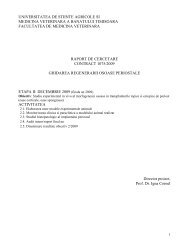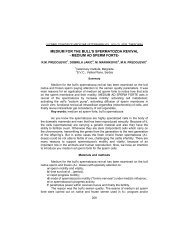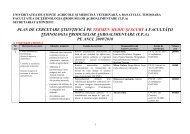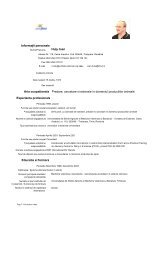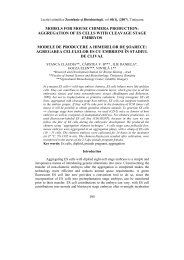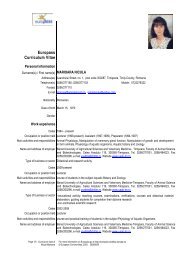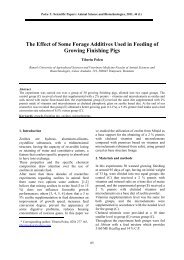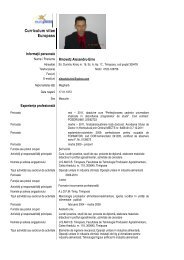Animal Science and Biotechnologies, 2011, 44 (2)
Animal Science and Biotechnologies, 2011, 44 (2)
Animal Science and Biotechnologies, 2011, 44 (2)
You also want an ePaper? Increase the reach of your titles
YUMPU automatically turns print PDFs into web optimized ePapers that Google loves.
Negrea O. et. al./Scientific Papers: <strong>Animal</strong> <strong>Science</strong> <strong>and</strong> <strong>Biotechnologies</strong>, <strong>2011</strong>, <strong>44</strong> (2)<br />
Incidence of Larval Anisakiosis in Ocean Fish Sold Through<br />
Network of Supermarket Stores<br />
Octavian Negrea, Vioara Mireşan, Camelia Răducu, Liviu Oană, Flore Chirilă,<br />
Zamfir Marchis, Daniel Cocan<br />
University of Agricultural <strong>Science</strong>s <strong>and</strong> Veterinary Medicine, Faculty of <strong>Animal</strong> <strong>Science</strong> <strong>and</strong> <strong>Biotechnologies</strong>,<br />
400372 Cluj-Napoca, 3-5 Manastur street, Romania<br />
Abstract<br />
Investigations conducted on a sample of 33 ocean fish of consumption, mackerel <strong>and</strong> herring uneviscerated <strong>and</strong><br />
frosen, packed in plastic bags, different weights <strong>and</strong> purchased from supermarket chain stores, concerning the<br />
incidence <strong>and</strong> intensity of parasitism by larvae of Anisakis sp. to gut <strong>and</strong> visceral level, lesion picture caused <strong>and</strong><br />
also some morphological measurements, reveals an incidence of anisakiasis of 60.0% to 72.2% in mackerel <strong>and</strong><br />
respectively in herring. Regarding the infestation intensity of Anisakis larvae sp., infestations dominate weakly the<br />
mackerel (<strong>44</strong>.4%), followed by medium (33.3%) <strong>and</strong> massive (22.0%). In contrast to the herring are dominant the<br />
medium infestations (46.1%), followed by massive (30.7%) <strong>and</strong> low infestations (23.1%).Table of lesion caused by<br />
larval stages in gut <strong>and</strong> visceral level is characterized by intestinal congestion, hemorrhagic enteritis <strong>and</strong> hemoragico<br />
– necrotic <strong>and</strong> the presence of larval cystic foci on serous of gut, kidneys, liver <strong>and</strong> gonads. Morphological<br />
investigations carried out on a sample of 20 larvae, collected from herring <strong>and</strong> mackerel, regarding biometric aspects,<br />
cuticular <strong>and</strong> of color, body size variables highlights from 13.0 mm / 0.6 mm minimum to 27.0 / 0.6 mm maximum,<br />
with an average of 20.0 mm / 0.5 mm, comparable to those presented in the speciality literature.<br />
Keywords: cyst, larva, lesions zoonosis.<br />
1. Introduction<br />
At present, in the world, anisakiosis shows a real<br />
danger to human communities consuming fish<br />
(ichthyophagous populations), such as Japan,<br />
Thail<strong>and</strong>, USA etc., <strong>and</strong> especially for populations<br />
in geographic areas considered nonichthyophagous<br />
(ex.Romania) once with the diversity of food<br />
resources <strong>and</strong> increasing interest in fish <strong>and</strong><br />
seafood. In this context, in recent times, including<br />
in Romania there is a massive import of fish <strong>and</strong><br />
seafood from anisakigenous areas, fresh or chilled<br />
life, a situation that favors survival of a live larvae<br />
closer to the consumer. 1 Another risk is the<br />
adaptation by consumers in areas of fashion<br />
nonichthiofagous consumption of raw fish or<br />
* Corresponding author: Negrea Octavian, E-mail:<br />
onegrea50@yahoo.com<br />
cooked foods such as sushi range Japanese<br />
products.<br />
Anisakiosis danger to humans is that if it<br />
accidentally eat meat <strong>and</strong> / or viscera of fish or<br />
seafood with live or dead larvae, risk being the<br />
victim of two serious pathological manifestations,<br />
an acute allergic syndrome (nausea, vomiting <strong>and</strong><br />
violent colics) <strong>and</strong> / or chronic enteral syndrome<br />
(subocclusions or intestinal occlusion). From these<br />
considerations, it are requiring a series of<br />
measures that people are aware of the danger of<br />
this disease but also a thorough health inspection<br />
of all meat-based products, fish offal <strong>and</strong> seafood<br />
from areas considered anisakigenous.<br />
2. Materials <strong>and</strong> methods<br />
Investigations were conducted during January-<br />
February <strong>2011</strong>, on a sample of 33 non-eviscerated<br />
marine fish <strong>and</strong> frozen (15 pieces mackerel species,<br />
35
Negrea O. et. al./Scientific Papers: <strong>Animal</strong> <strong>Science</strong> <strong>and</strong> <strong>Biotechnologies</strong>, <strong>2011</strong>, <strong>44</strong> (2)<br />
Scomber scombus <strong>and</strong> 18 pieces herring - Clupea<br />
heringus), packed in plastic bags (3-5 pieces per bag)<br />
<strong>and</strong> a variable weight (200-400 g). We mention that the<br />
fish taken in the study came from the waters of Norway<br />
<strong>and</strong> Spain, imported <strong>and</strong> packed by specialized<br />
companies in Romania in the field. After thawing,<br />
macroscopic examination was performed by opening<br />
the general cavity, following intestinal parasites,<br />
changes of organs in general cavity <strong>and</strong> lesion table<br />
produced in gut level by larval stages of Anisakis sp.<br />
From parasitized specimens were collected parasites in<br />
Petri dishes with 10% formalin solution for some<br />
morphological measurements. To appreciate the<br />
intensity of larval parasitism, were evaluated<br />
numerically parasites located in the gut, setting:<br />
- low infestation, under 5 parasites/ fish<br />
- medium infestation, between 5 – 10 parasites/fish<br />
- high infestation, above 10 parasites / fish.<br />
There have been done some morphological<br />
measurements (length, width, color) on a sample of 20<br />
larvae collected, using a millimeter graduated linear.<br />
3. Results <strong>and</strong> discussion<br />
Investigations conducted on a sample of 33 marine<br />
fish, non eviscerated <strong>and</strong> frozen, buy in the<br />
supermarket chain stores, the incidence <strong>and</strong><br />
intensity of parasitism by larval Anisakis sp,<br />
lesion table caused <strong>and</strong> some morphological<br />
measurements, reveals the following aspects:<br />
A. Parasitism incidence with Anisakis sp larva in<br />
consumption marine fish is presented in<br />
accompanying table.<br />
The data presented in the table below highlights a<br />
high level of anisakiosis in marine fish by 60.0% to<br />
72.2% in mackerel <strong>and</strong> herring, with an average of<br />
66.6%. Like other helmintozis found in fish<br />
(freshwater <strong>and</strong> marine fauna) <strong>and</strong> nematodes<br />
responsible anisakiasis, in their biological cycle<br />
requires a definitive host (ichtiofage marine<br />
mammals) <strong>and</strong> 2-3 intermediate hosts (capepodes<br />
crustaceans <strong>and</strong> marine fish ) in which the body<br />
develops stages larval L1 - L4. [1, 2, 3, 4].<br />
Contamination of marine <strong>and</strong> ocean fish is more<br />
intense, the higher is the most developed invertebrate<br />
fauna (food source for fish). Thus the incidence of<br />
parasites in marine fish crustacean is correlated with<br />
the amount consumed <strong>and</strong> their pollution level<br />
especially with larvae Anisakis spp [5, 2].<br />
Variety of intestinal infestation with larvae of<br />
Anisakis sp from marine fish consumption,<br />
depending on the species is shown in Figure 1.<br />
Table 1. Anisakiosis incidence in comsumption marine fish<br />
Species Total tested samples From which positive %<br />
Mackerel 15 9 60.0<br />
Herring 18 13 72.2<br />
Total 33 22 66.6<br />
80<br />
60<br />
40<br />
60<br />
72,2<br />
66,6<br />
20<br />
0<br />
Mackerel Herring Total<br />
Figure 1. Variety of intestinal infestation with larvae of Anisakis sp.<br />
B. Infestation intensity level with the larvae of<br />
Anisakis sp in consumption marine fish, on fish<br />
lot taken in the study, is presented in Table 2. The<br />
data presented in Table 2 highlights the different<br />
levels of intensity Anisaki sp larvae parasitism,<br />
depending on the species, as follows:<br />
36
Negrea O. et. al./Scientific Papers: <strong>Animal</strong> <strong>Science</strong> <strong>and</strong> <strong>Biotechnologies</strong>, <strong>2011</strong>, <strong>44</strong> (2)<br />
- in meckerel species (comber scombrus)<br />
dominates low infestations (<strong>44</strong>,4%),<br />
followed by those medium (33,3%) <strong>and</strong><br />
high (22,2)<br />
- in herring species (Clupea herengus),<br />
medium infestations (46,1%) are<br />
dominant, followed by those with high<br />
level (30,7%) <strong>and</strong> low (23,1%)<br />
Table 2. Infestation intensity with Anisakis sp larva in marine fish, on species<br />
Species<br />
From which<br />
Number of<br />
Low infestation Medium infestation High infestation<br />
positive<br />
Number of<br />
Number of<br />
Number of<br />
samples<br />
%<br />
%<br />
%<br />
samples<br />
samples<br />
samples<br />
Mackerel 9 4 <strong>44</strong>.4 3 33.3 2 22.2<br />
Herring 13 3 23.1 6 46.1 4 30.7<br />
Total 22 7 31.5 9 40.9 6 27.2<br />
In the next graphic there are are presented<br />
percentage values in anisakiosis intensity of<br />
parasitism in larval marine fish sample taken in<br />
the study<br />
Anisakiasis in marine fish is a disease with a<br />
nonspecific clinical picture, insignificant. Man,<br />
however, can become accidental hosts after<br />
consumption of raw or undercooked fish in heattreated<br />
condition.[1, 2, 3, 4, 6]. Most sources of<br />
infestation for humans are given the traditional<br />
dishes of raw herring (Lomi-Lomi), salmon<br />
(ceviche, sushi, sashimi). Unfortunately, in<br />
humans the disease is extremely severe clinical<br />
picture expressed by an acute allergic syndrome<br />
(nausea, vomiting, abdominal cramps) <strong>and</strong>/or<br />
chronic enteral syndrome (subocclusions <strong>and</strong><br />
intestinal occlusion) whose only treatment is<br />
surgical.[7, 8, 9].<br />
50<br />
40<br />
30<br />
20<br />
10<br />
0<br />
<strong>44</strong>,4<br />
23,1<br />
31,5 33,3 46,1<br />
40,9<br />
22,2<br />
30,7 27,2<br />
Low inf. Med. inf. Massive<br />
inf.<br />
Mackerel Herring Total<br />
Figure 2. Percentage values in anisakiosis intensity of parasitism in larval marine fish<br />
C. Regarding the pathological table, most lesions<br />
are confined to the gut, <strong>and</strong> other locations are<br />
possible. These consist of:<br />
- intestinal mucosal congestion<br />
- lesions of hemorrhagic enteritis <strong>and</strong> necrotic<br />
hemoragic in focus, especially in heavy<br />
infestations when larvae are encysted [1, 2]<br />
- degenerative liver <strong>and</strong> renal lesions characterized<br />
by the presence of nodular foci <strong>and</strong> white rings on<br />
the surface <strong>and</strong> deep<br />
- the presence of cystic larval forms, located on<br />
the serosal bowel, gonads, in the form of nodules<br />
3-4 mm with a perifocous fibroconjunctival<br />
reaction.[3].<br />
37
Negrea O. et. al./Scientific Papers: <strong>Animal</strong> <strong>Science</strong> <strong>and</strong> <strong>Biotechnologies</strong>, <strong>2011</strong>, <strong>44</strong> (2)<br />
Figure 3. Anisakis sp. larva, encysted in gonads structure, in mackerel<br />
D. Morphological investigations carried out on 20<br />
larvae collected from the intestinal lumen, pyloric<br />
appendices from marine fish infected with larval<br />
anisakiasis by biometrics, are shown in Table 3.<br />
Values obtained following biometric<br />
measurements on a sample of 20 larvae, collected<br />
from herring with anisakiosis, are between 13.0<br />
mm / 0.6 mm (minimum value) <strong>and</strong> 27.0 mm / 0.6<br />
mm (maximum value) with a mean of 20.0 mm /<br />
0.5 mm. Doing a comparison of data obtained<br />
with those presented in the literature, they are like<br />
identical for Anisakis genre.[2, 3, 7, 8].<br />
Table 3. Biometrics done on Anisakis larvae collected from marine fish sp.<br />
Sample number<br />
dimensions<br />
Length (mm) Width (mm)<br />
cuticule<br />
colour<br />
1 15.0 0.4 Ring. rough Dirty yellow<br />
2 22.0 0.6 “ “<br />
3 19.0 0.5 “ “<br />
4 27.0 0.4 “ “<br />
5 20.0 0.6 “ “<br />
6 22.0 0.6 “ “<br />
7 18.0 0.5 “ “<br />
8 20.0 0.6 “ “<br />
9 21.0 0.5 “ “<br />
10 22.0 0.6 “ “<br />
11 13.0 0.6 rings yellow<br />
12 24.0 0.5 rough “<br />
13 22.0 0.5 “ “<br />
14 17.0 0.4 “ “<br />
15 19.0 0.5 “ “<br />
16 19.0 0.3 “ “<br />
17 23.0 0.5 “ “<br />
18 21.0 0.7 “ “<br />
19 17.0 0.6 “ “<br />
20 20.0 0.4 “ “<br />
Average 20.0 0.5 “ “<br />
4. Conclusions<br />
Investigations conducted on a sample of 33<br />
consumtion marine fish, mackerel <strong>and</strong> herring,<br />
non gutted <strong>and</strong> frozen, purchase of supermarket<br />
chain stores, the incidence <strong>and</strong> intensity of<br />
parasitism on larval anisakiasis, lesion table<br />
caused, <strong>and</strong> also some morphological<br />
measurements, reveals the following aspects:<br />
38
Negrea O. et. al./Scientific Papers: <strong>Animal</strong> <strong>Science</strong> <strong>and</strong> <strong>Biotechnologies</strong>, <strong>2011</strong>, <strong>44</strong> (2)<br />
1. Larval anisakiosis incidence is high, with<br />
differing values depending on the species, 60.0%<br />
to 72.2% in mackerel <strong>and</strong> herring, with an average<br />
of 66.6%.<br />
2. Larval parasitism intensity shows different<br />
values depending on species. In mackerel,<br />
dominates low infestations, <strong>44</strong>.4%, followed by<br />
average, 33.3%, <strong>and</strong> then heavy infestations,<br />
22.2%. In herring medium infestations, 46.1%, are<br />
the dominant ,followed by massive infestations<br />
<strong>and</strong> respectively, poor of 30.7% <strong>and</strong> 23.1%.<br />
3. The lesion table caused in gut <strong>and</strong> visceral level<br />
is characterized by intestinal congestion, bleeding<br />
<strong>and</strong> hemorrhagic necrotic enteritis, the presence of<br />
serous cystic larval foci localized on intestinal<br />
serous, kidneys <strong>and</strong> gonads.<br />
4. Morphological investigations carried out by<br />
biometrics on a sample of 20 larvae collected from<br />
herring <strong>and</strong> mackerel, emphasize variables body<br />
size, from 13.0 mm / 0.6 mm to 27.0 mm / 0.6<br />
mm, with an average of 20, 0 mm / 0.5 mm,<br />
comparable to those in the speciality literature.<br />
References<br />
1. Lancrajan, D., Rotaru, O., Analiza Riscurilor<br />
consumului necontrolat al carnurilor, Editura Cetatea<br />
Deva, 2009<br />
2. Munteanu, G., Bogatu, D., Tratat de ihtiopatologie<br />
pag.484 - 490, Editura Excelsior Art., 2003<br />
3. Negrea, O., Bolile pestilor. Editura AcademicPres,<br />
Cuj-Napoca, 2007<br />
4.http://coursdeparasitologie.ifrance.com/Parasites/Ani<br />
sakiase.htmhttp://www.ceirsa.org/allegati/alt_image/im<br />
age_0199.jpg<br />
5. Appleby, D., Kapoor, W., Karpf, M. <strong>and</strong> Williams,<br />
S, Anisakiasis—nematode infestation producing smallbowel<br />
obstruction. Arch. Surg., 1982, 117, 836<br />
6.http://www.scielo.br/img/revistas/bn/v8n2/a10fig01.g<br />
if<br />
7. Otel,V., Constantin, Ghe.,Ghid ihtiopatologic pentru<br />
piscicultura din Delta Dunarii. Buletin de cercetari<br />
piscicole, supliment., Bucuresti, 1989, 11-150<br />
8. Roberts, R. J., Fish Pathology- Second Edition Edit.<br />
Bailliere Tindall Londra, 1989, pp. 1-405<br />
9.http://coursdeparasitologie.ifrance.com/images/Helmi<br />
nthes/Anisakiase/Anisakis%20granulome<br />
39



